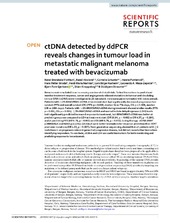| dc.contributor.author | Forthun, Rakel Brendsdal | en_US |
| dc.contributor.author | Hovland, Randi | en_US |
| dc.contributor.author | Schuster, Cornelia | en_US |
| dc.contributor.author | Puntervoll, Hanne Eknes | en_US |
| dc.contributor.author | Brodal, Hans Petter | en_US |
| dc.contributor.author | Namløs, Heidi Maria | en_US |
| dc.contributor.author | Aasheim, Lars Birger | en_US |
| dc.contributor.author | Meza, Leonardo Zepeda | en_US |
| dc.contributor.author | Gjertsen, Bjørn Tore | en_US |
| dc.contributor.author | Knappskog, Stian | en_US |
| dc.contributor.author | Straume, Oddbjørn | en_US |
| dc.date.accessioned | 2020-08-14T11:16:43Z | |
| dc.date.available | 2020-08-14T11:16:43Z | |
| dc.date.issued | 2019 | |
| dc.Published | Forthun RB, Hovland R, Schuster C, Puntervoll HE, Brodal HP, Namløs HM, Aasheim LB, Meza ZL, Gjertsen BT, Knappskog S, Straume O. ctDNA detected by ddPCR reveals changes in tumour load in metastatic malignant melanoma treated with bevacizumab. Scientific Reports. 2019;9:17471 | eng |
| dc.identifier.issn | 2045-2322 | |
| dc.identifier.uri | https://hdl.handle.net/1956/23765 | |
| dc.description.abstract | Bevacizumab is included in an increasing number of clinical trials. To find biomarkers to predict and monitor treatment response, cancer and angiogenesis relevant mutations in tumour and circulating tumour DNA (ctDNA) were investigated in 26 metastatic melanoma patients treated with bevacizumab. Patients with >1% BRAF/NRAS ctDNA at treatment start had significantly decreased progression free survival (PFS) and overall survival (OS) (PFS: p = 0.019, median 54 vs 774 days, OS: p = 0.026, median 209 vs 1064 days). Patients with >1% BRAF/NRAS ctDNA during treatment showed similar results (PFS: p = 0.002, OS: p = 0.003). ≤1% BRAF/NRAS ctDNA and normal lactate dehydrogenase (LDH) levels both significantly predicted increased response to treatment, but BRAF/NRAS ctDNA was better at predicting response compared to LDH at treatment start (OR 16.94, p = 0.032 vs OR 4.57, p = 0.190), and at predicting PFS (HR 6.76, p = 0.002) and OS (HR 6.78, p = 0.002) during therapy. ctDNA BRAF p.V600D/E/K and NRAS p.G12V/p.Q61K/L/R were better biomarkers for response prediction than TERT promoter mutations (OR 1.50, p = 0.657). Next generation sequencing showed that all patients with ≥2 mutations in angiogenesis-relevant genes had progressive disease, but did not reveal other biomarkers identifying responders. To conclude, ctDNA and LDH are useful biomarkers for both monitoring and predicting response to bevacizumab. | en_US |
| dc.language.iso | eng | eng |
| dc.publisher | Nature Research | eng |
| dc.rights | Attribution CC BY | eng |
| dc.rights.uri | http://creativecommons.org/licenses/by/4.0 | eng |
| dc.title | ctDNA detected by ddPCR reveals changes in tumour load in metastatic malignant melanoma treated with bevacizumab | en_US |
| dc.type | Peer reviewed | |
| dc.type | Journal article | |
| dc.date.updated | 2020-02-04T13:46:25Z | |
| dc.description.version | publishedVersion | en_US |
| dc.rights.holder | Copyright 2019 The Author(s) | |
| dc.identifier.doi | https://doi.org/10.1038/s41598-019-53917-5 | |
| dc.identifier.cristin | 1786394 | |
| dc.source.journal | Scientific Reports | |

